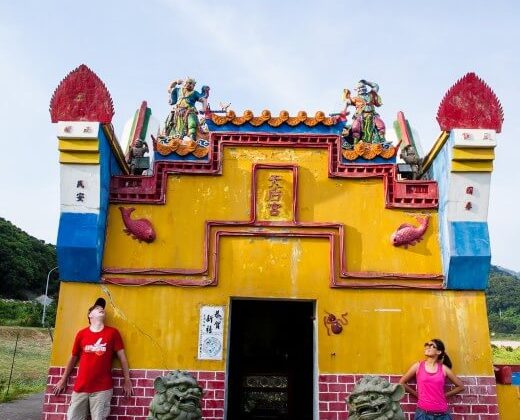Text: Rick Charette
Photos: Vision
The Beitou (北投) hot-spring district, now long enclosed within the borders of Taipei City, was voted one of Taiwan’s “Top 10 Tourist Towns” in a nationwide poll and expert survey concluded in 2012. Travel in Taiwan recently spent an afternoon with Yang Yeh, well-known Taiwan mapmaker, resident of Beitou since childhood, and expert on its history and culture.
The hot-spring area, which percolates with resort hotels, public baths, and tourist attractions is close to MRT Xinbeitou Station. From the station you’ll see a long, narrow, valley directly ahead, sloping upward toward the high hills and peaks of the Yangmingshan massif looming behind. This valley was carved by the Beitou Stream (北投溪), a hot-spring stream that gurgles and steams. It runs through long, narrow Beitou Park, which takes up the center of the lower part of the valley. Beitou Stream
Beitou Stream
The metro station is, says Yang, the best place to launch a day-tour of the hot-spring enclave, because the area’s history as a resort was also launched here. The Japanese developed the valley during their 1895-1945 period of colonial rule over Taiwan, and built a large and lovely wooden railway station in 1916 on a spot right beside today’s metro station to serve as the terminus on a spur line specially built to deliver soakers from a then much smaller Taipei.
Old-time Beitou residents are very happy these days, says Yang, because government officials recently announced that the station, relocated to Taiwan Folk Village in Changhua County in 1992, is being returned to Taipei, and will be re-erected in small Qixing Park (七星公園) beside the metro station by 2016. (Read also: Seven Star Mountain, a Hike You Cannot Miss While in Taipei)
The entrance to Beitou Park (北投公園) is just across the street from the metro station. There are a number of small Beitou Stream waterfalls within the park. “Early on, before many facilities were developed, Japanese nationals would come here and soak in the pools below the falls – naked, in the Japanese fashion. This caused quite a stir with locals, and Japanese officials thought it best to stop the practice, to maintain Japanese dignity and esteem.” (Today only foot-soaking is allowed in the stream.) Small inns and baths began to pop up.
One of the earliest, a simple bathhouse called Longnaitang (瀧乃湯), is still in operation beside the park. It was built in 1907, has separate male/female pools, and today requires swimwear. Two other places from the Japanese era are also still in business. The Yitsun Hotel (逸村大飯店), originally a private guesthouse for Japanese military officers, includes Sun Yat-sen among its famous guests. The pretty wood-built Whispering Pine Inn (吟松閣), built in 1934, is further up the valley, above the park.
In Yang’s view, of the many attractions in the hot-spring area, manmade and natural, the Beitou Hot Spring Museum (北投溫泉博物館), located just inside the park at its lower end, is a must-visit. This lovely Victorian-style building of red brick and white stucco originally housed the Beitou Public Baths, Taiwan’s first public bath and long East Asia’s largest hot-spring public bath. A Romanesque pool and columns have been restored, as has the original large, breezy tatami resting room, and there are many intriguing artifacts and info displays. Says Yang: “A highlight for me at the museum is the fine collection of black & white photos and documentary footage of Beitou and Taipei’s riverside areas in the Japanese period, which is great for visualizing what everything used to look like as you tour the area.”
Higher up in the park you’ll come to Plum Garden (梅庭). This is an attractive Japanese-style villa made of timber, with Western elements, that was built in the 1930s. It was the summer home of the esteemed politico and calligrapher Yu You-ren from 1949 to 1964. Inside the heritage home is a visitor information center, and there are displays on Yu’s calligraphy as well as the villa’s distinctive architecture and decorative elements. “The villa was originally built for the use of Japanese military officers,” says Yang, “and the basement has an air-raid shelter built with reinforced concrete during WW II. The external wall is a battlement-shaped structure, as if the Japanese expected the Americans to one day come fighting up the valley.” Plum Garden
Plum Garden
In a very small side valley near the top of the park is Geothermal Valley (地熱谷) Beitou Stream’s sulfur-water source, popularly called Hell Valley. This is the heart of the hot-springs area. A deep, rock-strewn depression created by a volcanic burst long ago, it’s filled with what’s more a lake than a pool, the sulfurous waters bubbling and spitting, the steam sometimes filling the entire little valley on cool days. These are the Yangmingshan massif’s hottest waters, at about 100 degrees Celsius. Yang says that the Ketagalan called the mist- and steam-filled hot-springs area ‘Patauw,’ meaning ‘witch’ or ‘sorceress,’ and considered the enclave sacred. The Chinese place name ‘Beitou’ is a bastardization of the original name.
At the top of the valley on Youya Road is the lovely Beitou Museum (北投文物館; formerly known as the Taiwan Folk Art Museum), housed in a former Japanese hot-spring inn built in 1921 that served as an imperial officers’ club and once entertained kamikaze pilots on their final nights of mortality. The complex is among Taiwan’s largest examples of Japanese wood-built architecture, measuring about 2,500 square meters. Built in Chinese Tang Dynasty style, it was renovated top to bottom 2002~2007, and is a work of art in itself.
The museum has Beitou-theme exhibits on early Taiwan life and culture. Beitou was once a key area in Taiwan ceramics production, with well-suited mineral-rich earth, and the museum has many compelling high-end works, with historical background provided. Yang recommends the black & white photos from the area’s Japanese colonial-period heyday, when the developed valley looked nothing like it does today.
Beside the museum is the Marshal Zen Garden (少帥禪園), also called the Shann Garden. This was, says Yang, for a time the home of the “Young Marshal,” Zhang Xue-liang, a Manchurian warlord best known for kidnapping Generalissimo Chiang Kai-shek in 1936. He lived to tell the tale, though under house arrest, and lived here while the home he lived in longest while under the Kuomintang’s care, elsewhere in Beitou and not open to the public, was built.
During the Japanese era, the aesthetically magnetic complex of Japanese-built wooden structures served as a hot-spring inn, officers’ club, and short-stay R&R retreat for kamikaze pilots. It is now run as a teahouse/restaurant/spa enterprise.
This article was published in Travel in Taiwan magazine (Nov./Dec., 2013)
Can’t wait for taking a hot spring right away? Just join our “Bath of the Gods“now!!
More on hot springs: Hot Springs, Spas and Spa Hotels Around Taiwan
















Comments are closed.